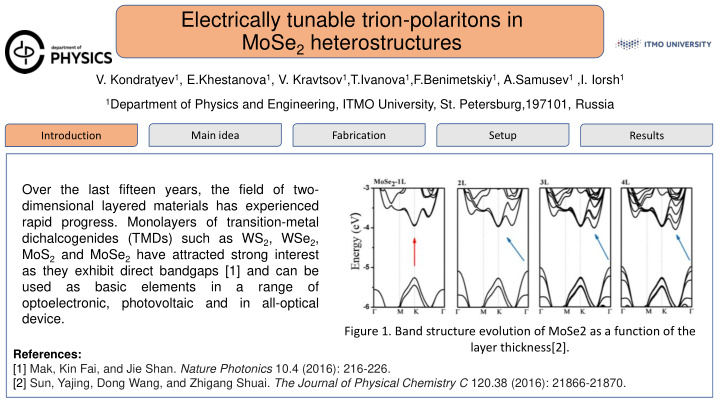



Electrically tunable trion-polaritons in MoSe 2 heterostructures V. Kondratyev 1 , E.Khestanova 1 , V. Kravtsov 1 ,T.Ivanova 1 ,F.Benimetskiy 1 , A.Samusev 1 ,I. Iorsh 1 1 Department of Physics and Engineering, ITMO University, St. Petersburg,197101, Russia Introduction Main idea Fabrication Setup Results Over the last fifteen years, the field of two- dimensional layered materials has experienced rapid progress. Monolayers of transition-metal dichalcogenides (TMDs) such as WS 2 , WSe 2 , MoS 2 and MoSe 2 have attracted strong interest as they exhibit direct bandgaps [1] and can be used as basic elements in a range of optoelectronic, photovoltaic and in all-optical device. Figure 1. Band structure evolution of MoSe2 as a function of the layer thickness[2]. References: [1] Mak, Kin Fai, and Jie Shan. Nature Photonics 10.4 (2016): 216-226. [2] Sun, Yajing, Dong Wang, and Zhigang Shuai. The Journal of Physical Chemistry C 120.38 (2016): 21866-21870.
Electrically tunable trion-polaritons in MoSe 2 heterostructures V. Kondratyev 1 , E.Khestanova 1 , V. Kravtsov 1 ,T.Ivanova 1 ,F.Benimetskiy 1 , A.Samusev 1 ,I. Iorsh 1 Introduction Main idea Fabrication Setup Results Motivation Scheme of proposed device The optical properties of TMDs are defined by the formation of bound electro neutral excitonic (X 0 ) and (X − X + ) charged trionic or states, which are characterized by the large binding energies on the order of 100 meV and an increased oscillator strength [3]. Trions are charged particles which makes them highly electrically tunable and promising for the engineering of electro-optical devices. In the present work, we realize the concept of electrically-driven trion-polaritons and demonstrate the electrically tunable polariton gap. References: [3] Wang, Haining, et al. " Physical Review B 93.4 (2016): 045407.
Electrically Tunable Trion-polaritons in MoSe 2 Heterostructures V. Kondratyev 1 , E.Khestanova 1 , V. Kravtsov 1 ,T.Ivanova 1 ,F.Benimetskiy 1 , A.Samusev 1 ,I. Iorsh 1 Introduction Main idea Fabrication Setup Results Methods Sample hBN 1.66 We engineered a photonic structure consisting max of a MoSe 2 /hBN heterostructure placed on top X 0 of Ta 2 O 5 grating. To create a proper contact to 1.64 MoSe 2 , electron beam lithography through a PL intensity Energy (eV) polymethyl acrylate mask. During the 1.62 lithographic process, the areas for contact were X - opened in the mask layer and Ti/Au metal MoSe 2 1.60 contacts were deposited using thermal evaporation. We chose Ti as an adhesive layer Ta2O5 because of its work function (4.3 eV) being 1.58 close to the electron affinity of MoSe 2 (3.8 eV) min Contact and hence should promote a low Schottky -300 -200 -100 0 100 200 300 barrier at the metal/semiconductor contact. The V sample (V) electrical tuning of the device consists of the Fig2. (a)Optical microscopy image of fabricated sample. application of a vertical field (gate) which (b) Plot of photoluminescence (PL) spectra versus gate voltage. changes the Fermi level of the monolayer MoSe 2 and thus the concentration of trions.
Electrically Tunable Trion-polaritons in MoSe 2 Heterostructures V. Kondratyev 1 , E.Khestanova 1 , V. Kravtsov 1 ,T.Ivanova 1 ,F.Benimetskiy 1 , A.Samusev 1 ,I. Iorsh 1 Introduction Main idea Fabrication Setup Results Setup for microphotoluminescence spectroscopy in Fourier plane imaging configuration. We characterize the gate dependence of the total photoluminescence of our device. For this, we employ a setup which contains a closed-cycle helium cryostat with a base temperature of 7K. To excite photoluminescence we use He-Ne laser with a wavelength of 632.8 nm. The beam was focused on a sample by an objective lens (Mitutoyo Objective 100x/0.7). The collected photoluminescence signal was directed to the slit spectrometer (Princeton SP2500, CCD camera PyLoN 400BReXcelon). To excite our sample electrically KEITHLEY Model 6487 was used, the voltage was applied to monolayer, ground to Si, to prevent the insulator breakdown we used built-in Fig3. Setup scheme current compliance.
Electrically Tunable Trion-polaritons in MoSe 2 Heterostructures V. Kondratyev 1 , E.Khestanova 1 , V. Kravtsov 1 ,T.Ivanova 1 ,F.Benimetskiy 1 , A.Samusev 1 ,I. Iorsh 1 Introduction Main idea Fabrication Setup Results a) b) c) d) 0V 200V 75V Au/Cr hBN MoSe2 X 0 X 0 Ta2O5 X 0 X 0 X - X - SiO2 V X - Si Fig4.(a) Scheme of device. (b)-(d) Angle-resolved reflectance spectra of the hybrid sample for different gate voltages. X 0 X 0 To observe trion-polaritons we investigate the angular dependence of the reflectance from our structure. For this, X - X - we use the setup for spectromicroscopy in Fourier plane imaging configuration. In the reflectance maps shown in Fig.4(d) it is clearly seen that at V = 0 V only excitonic polariton gap exists, while at V = 75 V a trion-polariton emerges. This results show that we have experimentally demonstrated electrically-tunable trion-polartion in planar optical cavity.
Recommend
More recommend